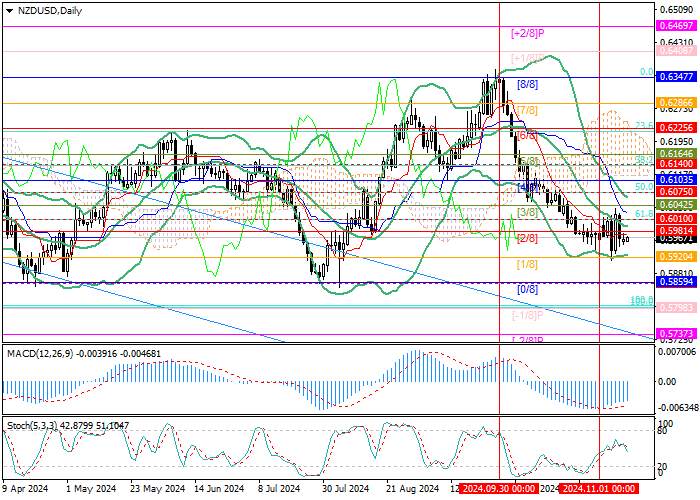
| Scenario | |
|---|---|
| Timeframe | Weekly |
| Recommendation | SELL STOP |
| Entry Point | 0.5920 |
| Take Profit | 0.5859, 0.5798, 0.5737 |
| Stop Loss | 0.5965 |
| Key Levels | 0.5737, 0.5798, 0.5859, 0.5920, 0.6010, 0.6103, 0.6164 |
| Alternative scenario | |
|---|---|
| Recommendation | BUY STOP |
| Entry Point | 0.6015 |
| Take Profit | 0.6103, 0.6164 |
| Stop Loss | 0.5950 |
| Key Levels | 0.5737, 0.5798, 0.5859, 0.5920, 0.6010, 0.6103, 0.6164 |
Current trend
The NZD/USD pair had mixed dynamics last week. Quotes reached 0.5910, but then recovered to 0.6037 amid instability caused by the results of the US presidential elections. However, overall, the medium-term downtrend remains as the New Zealand dollar remains under pressure from two main factors: the likelihood of significant trade disruptions and continued lowering of borrowing costs by the Reserve Bank of New Zealand.
The new head of the White House, Republican Donald Trump, has promised to impose tariffs on all foreign goods imported into the country, which has led to a significant weakening of assets alternative to the American currency, including the New Zealand dollar. During his first presidency, the politician already initiated similar tariffs on steel and aluminum, and this time they could range from 10.0% to 20.0% and may also affect beef produced in New Zealand. All this will put additional pressure on the national economy, which is already unable to fully recover after a long course of "hawkish" monetary policy: in the second quarter it contracted by 0.2% and, according to forecasts, may continue the negative trend in the third quarter, moving into recession. To prevent a significant drop-in business activity, the regulator will be forced to cut the interest rate by another 50 basis points at the November meeting.
In turn, US Federal Reserve officials may soon pause the cycle of easing monetary parameters, which is likely to be due to the position of the new White House administration. Experts fear that the introduction of additional trade tariffs, coupled with significant tax cuts, could lead to higher inflation rates, which would be an argument for officials to reconsider plans to rapidly reduce borrowing costs over the next year.
Thus, the current fundamental conditions favor a downward trend in the NZD/USD pair in the medium term.
Support and resistance
The key level for the "bears" seems to be 0.5920 (Murrey level [1/8]), a breakdown of which will ensure a continuation of the decline to the levels of 0.5859 (Murrey level [0/8]), 0.5798 (Murrey level [–1/8]), 0.5737 (Murrey level [–2/8]). A price consolidation above 0.6010 (Fibonacci retracement, 61.8%) may trigger a new rise to targets of 0.6103 (Murrey level [4/8]) and 0.6164 (Murrey level [5/8]).
Technical indicators do not deny further decline of the quotes: Bollinger Bands and Stochastic are reversing downwards, and MACD histogram is stable in the negative zone.
Resistance levels: 0.6010, 0.6103, 0.6164.
Support levels: 0.5920, 0.5859, 0.5798, 0.5737.

Trading tips
Short positions could be opened below 0.5920 with targets at 0.5859, 0.5798, 0.5737 and stop-loss at 0.5965. Implementation period: 5-7 days.
Long positions may be opened above 0.6010 with targets at 0.6103, 0.6164 and stop-loss at 0.5950.
风险提示:本文所述仅代表作者个人观点,不代表 Followme 的官方立场。Followme 不对内容的准确性、完整性或可靠性作出任何保证,对于基于该内容所采取的任何行为,不承担任何责任,除非另有书面明确说明。


加载失败()